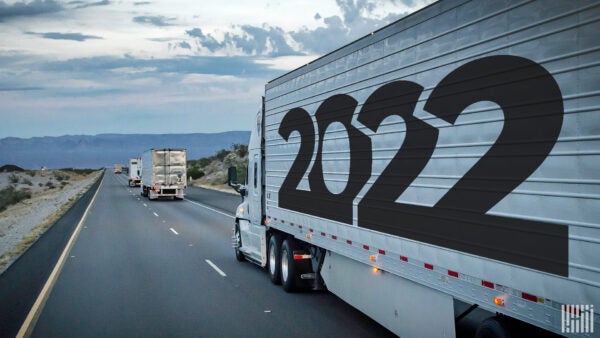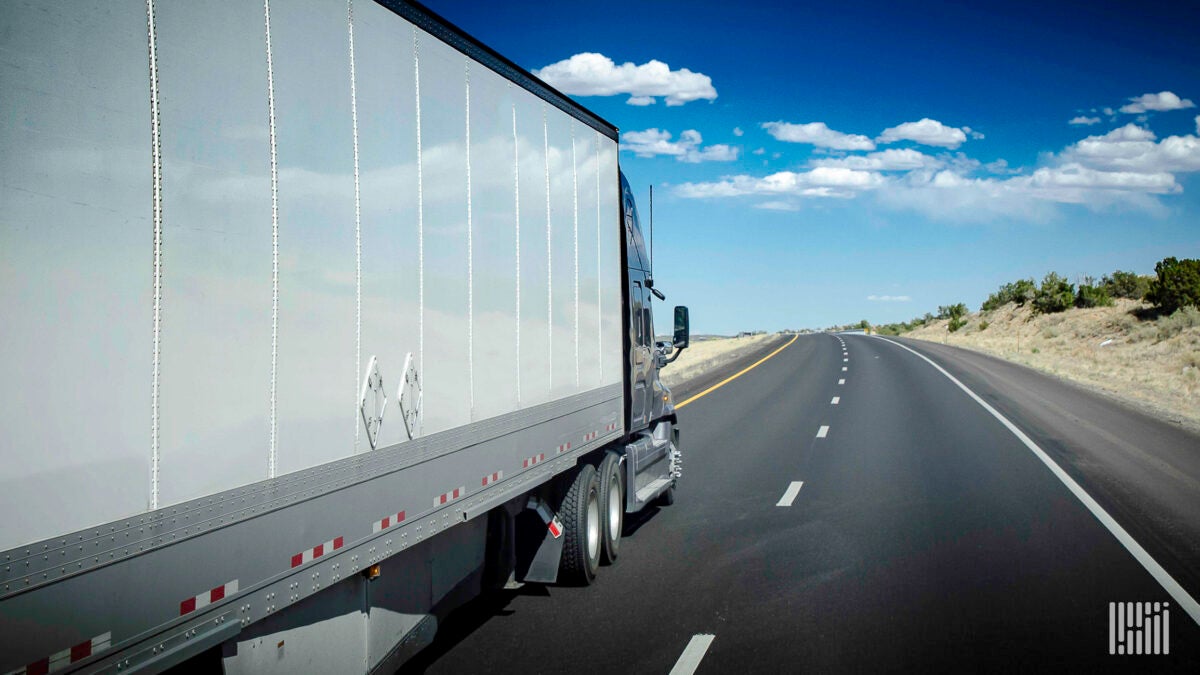Note these sobering statistics:
- Truckload spot rates have fallen by nearly one-third since the start of the year, while truckload contract rates have risen.
- The spread between truckload spot and contract rates is near an all-time high.
- Trucking spot rates always lead trucking contract rates, usually by about three months.
- Shippers (firms that buy trucking capacity from trucking companies) buy most of their capacity in the truckload contract market, which means they have not seen a reduction in freight rates as of yet.
- There are signs that truckload contract rates have peaked (gathered through a combination of survey, channel checks, and index models).
- Truckload contract rates could fall by $0.35/mile.
- Because the cost of diesel has doubled, it will take contract rates falling more than 12.5% before shippers would see a reduction in freight costs compared to the start of the year.
Bank of America survey of shippers
According to Bank of America’s (BoA’s) biweekly survey of shippers, trucking freight rates are set for an even larger pullback. This is bad news for trucking companies but good news on the inflation front.
The collapse in trucking spot rates has been well-documented by FreightWaves, but contract rates have held up so far. This is soon likely to change, at least according to results from the second-largest bank in the United States’ shipper survey.
The BoA shipper survey attempts to capture forward sentiment from 1,300 shippers, quantifying their views on demand, capacity and rates. Consumer-related shippers comprise 53% of the survey (retail and CPG), while industrial, manufacturing, materials, and healthcare shippers make up the balance. The survey results are aggregated every other week and have proven to be an incredibly reliable predictor of the future direction of the indicators the survey measures.
Beginning in late February results from the survey showed increasingly negative views on demand and rates. This tracks with freight market data that FreightWaves has been reporting for the past two months.

(Photo: Jim Allen/FreightWaves)
The indicators are reported as a diffusion index, which measures whether participants believe that the indicators are going to increase or decrease. When it comes to rates, anything above a 50 indicates that shippers believe rates are about to increase. Anything below 50 indicates that shippers believe rates will decrease.
Bank of America’s analysts wrote that “the Rate Indicator, which measures shippers’ views on truck rates, fell further from April’s collapse, falling again to 38.0, from 38.8 in the last survey, its lowest level since May 2020.”
Since most shippers buy all or most of their capacity under contracted rates, we can safely assume that shippers’ forward views on rates are mostly tied to their expectations for contract rates.
The decline in spot rates in 2022
Truckload van spot rates peaked on January 14, 2022, and have fallen 30% since, according to the National Truckload Index – Linehaul (NTIL.USA), which measures the underlying van spot rate net of fuel. The index peaked at $3.01/mile and currently sits at $2.09/mile.
Contract rates, on the other hand, have actually increased by 3% in the same period and are now at $2.91/mile.
During the same period, highway retail diesel prices, as measured by the U.S. Department of Energy’s weekly survey (DOE.USA) has jumped by 54%, or for a carrier operating at 6.5 MPG, $0.30/mile. With national van contract linehaul rates at $2.80/mile as of January 9, 2022, the fuel increase adds an 11% increase to contract rates.
When you combine fuel and linehaul rates, a shipper operating fully in the contract market would have seen a 14% increase in truckload van costs.
This surge largely explains the pain that Brian Cornell, the CEO of Target (NYSE: TGT), expressed this past week when describing the unanticipated rise in freight expenses the retailer has experienced so far in 2022, totaling more than $1 billion.
Spread between spot and contract rates
The spread between spot rates and contract rates is nearly as wide as it’s ever been (only slightly smaller than at the depth of the COVID lockdowns in April 2020). The spot to contract spread, net of fuel (RATES.USA) is -$0.80/mile. The largest spread in history was -$0.84/mile back in April 2020.
Looking back to 2019 (when the last freight recession occurred), the spread averaged -$0.43/mile throughout the year. This means that it was on average $0.43/mile cheaper to move a load on a spot market rate than a contract rate.
Truckload carriers will contend that the van contract rates do have some fuel embedded in them and it’s only fair to look at the spread in this light with spot rates having a small fuel base in the same way that contract rates do. Taking a $1.20/gallon base (RATES12.USA), the spot to contract spread is $0.63/mile. At a $2.00/gallon base (RATES20.USA), the spot to contract spread is $0.51/mile.
Regardless of the value that is used for the fuel base, the relationship between the current number and the prior number is relative. So a -$0.43/mile change in the spread between 2019 and 2022 will be consistent so long as the fuel base is consistent between the two periods.
With such a wide gap between spot and contract, why haven’t we seen contract rates fall?
The best explanation would be that the decline in trucking spot rates was very quick and caught almost everyone by surprise. We entered 2022 with bullish expectations about the economy and shippers experiencing the highest level of supply chain disorder in history. Few expected the economy to slow and even fewer anticipated that freight capacity would ease so quickly. Many shippers, stung by routing guides that fell into chaos in 2020, were understandably cautious about hastily cutting contract rates in response to spot market volatility.

But as tender rejections have dropped below 10% and the collapse of the spot market has demonstrated, available capacity has quickly returned to the market. As the Bank of America survey shows, shippers are now expecting contract rates to follow spot and rejection rates downward.
Contract rates have historically followed the direction of spot rates, with an approximate three-month delay. We are now past the three-month mark since spot rates peaked.
Sobering channel checks
We’ve heard from channel checks that shippers are taking action to cut their contracted freight costs. Over the past month, we’ve heard:
- A major shipper asked its 3PL for a 25% rate reduction in its contract bid but demanded that the reduction come from the brokerage margin and not from the spot carriers. The shipper said the 3PL would be subject to audits to ensure this happened.
- A truckload carrier was awarded a contract from a big box retailer but was given notice that this business would be moved to the retailer’s internal fleet. The retailer told the carrier that it had too much inventory per store and didn’t need as much for-hire capacity since it had a large private fleet.
- A large consumer products company had awarded contracted van fleets with 12% rate increases for the year but had recently asked for at least half of this back from the same carriers.
- A large beverage shipper had moved at least one-third of its contracted volume out of the routing guide and onto its internal load board.
While every shipper has different needs and risk tolerances, truckload carriers should expect some reduction in contact rates in the latter half of the year. It is possible that rate reductions may not happen until after the end of the second quarter and shippers may cautiously move some of their freight to cheaper carriers, hedging against the possibility that the freight market tightens once again.
If the market was to match the 2019 spot to contract spread, there is a risk that contract rates could fall as much as $0.35/mile, or 12.5%. Shockingly, if linehaul rates were to fall this much, the recent surge in diesel would take shippers’ contract truckload costs back to where they started the year and wouldn’t feel like much of a reduction.

This is not good news for trucking companies, as any decrease in the linehaul rate comes directly out of their operating margins. It is, however, good news for consumers and businesses that have had to deal with massive surges in freight rates over the past two years. A large portion of inflation is due to supply chain issues and transportation costs.
With logistics representing 12% of the global economy, the cost of freight has an outsized impact on inflation. The International Monetary Fund estimates that freight increases experienced in 2021 will add 1.5% in overall inflation to the economy this year. If freight rates have peaked, it would offer some relief that at least one inflationary input has at least stalled or peaked for the COVID cycle and that should be welcome news for everyone.
Interested in near real-time supply chain data and intelligence? Sign up for a SONAR demo and discover how the freshest and fastest data can make your supply chain more resilient.







